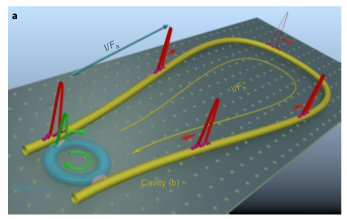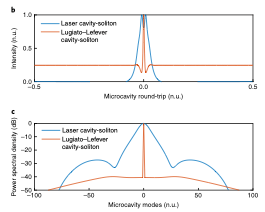Laser Cavity Solitons for Frequency Microcombs
A new frequency comb generator based on laser cavity solitons circulating in a microring optical resonator has been realised. Such device reduces the average power by an order of magnitude while increasing mode efficiency by 70%. Frequency combs find applications in optical metrology, optical atomic clocks, new GPS technologies and optical communications. An international collaboration has realised a new frequency-comb device based on laser cavity solitons (LCS) propagating in a micro-resonator (see Nature Photonics at https://doi.org/10.1038/s41566-019-0379-5). Researchers at the Universities of Sussex, Hong-Kong, Montreal (Canada), Swinburne (Melbourne, Australia), and Gian-Luca Oppo of our Physics Department have developed a micro-ring resonator coupled with an amplifying fibre loop (see Fig 1. a)) for the generation of LCS (see Fig. 1 b)), i.e. optical pulses with extremely broad spectra (see Fig. 1 c)). In terms of frequency combs, the performance of this new device based on LCS compares very well with respect to more conventional passive cavity soliton devices in that pulses have no background, required average powers are reduced by an order of magnitude and mode efficiency is increased by 70%. Frequency combs find applications in optical metrology, frequency-chain generation, optical atomic clocks, high precision spectroscopy, optical communications, GPS technologies, synthesis of waveforms and radio-frequency photonics.
The project and its success have been made possible by funds, support, ideas and facilities provided by staying in and taking part to the European Research Council, the European Commission and the Marie Curie Actions of the European Union.


Figure 1. a) The device: a short pulse (green) propagates in the microcavity (blue) sustained by a longer pulse (red) and a weak higher-order ‘super-mode pulse’ (purple) in the amplifying loop (yellow). b) Comparison of a laser cavity soliton pulse (blue) with a passive cavity soliton pulse (red). c) Spectra of the LCS (blue) and conventional passive cavity soliton (red).
Laser cavity solitons were originally discovered in the direction perpendicular to light propagation by Thorsten Ackemann and Willie Firth in the Physics Department of Strathclyde University in 2008.
April 2019